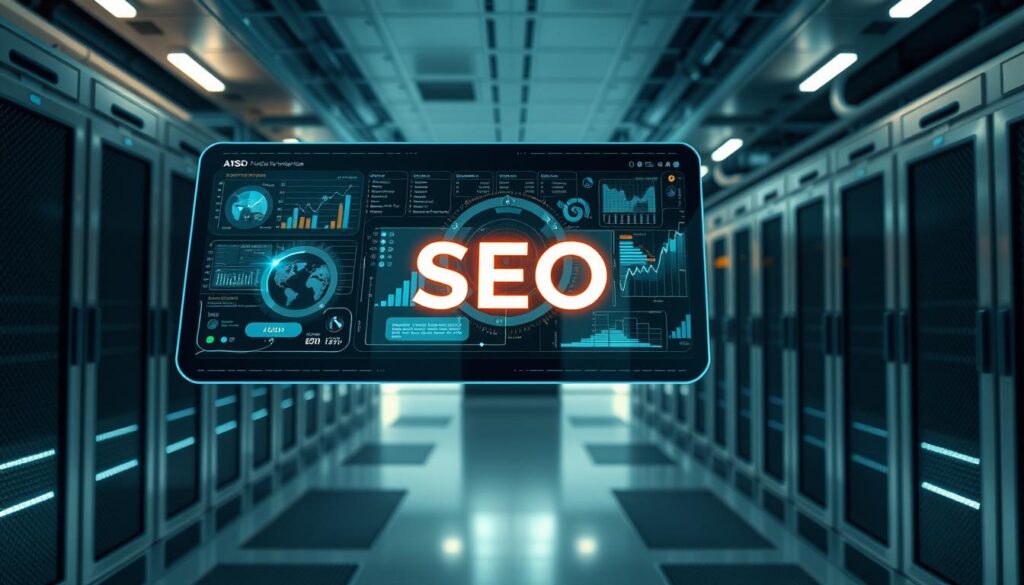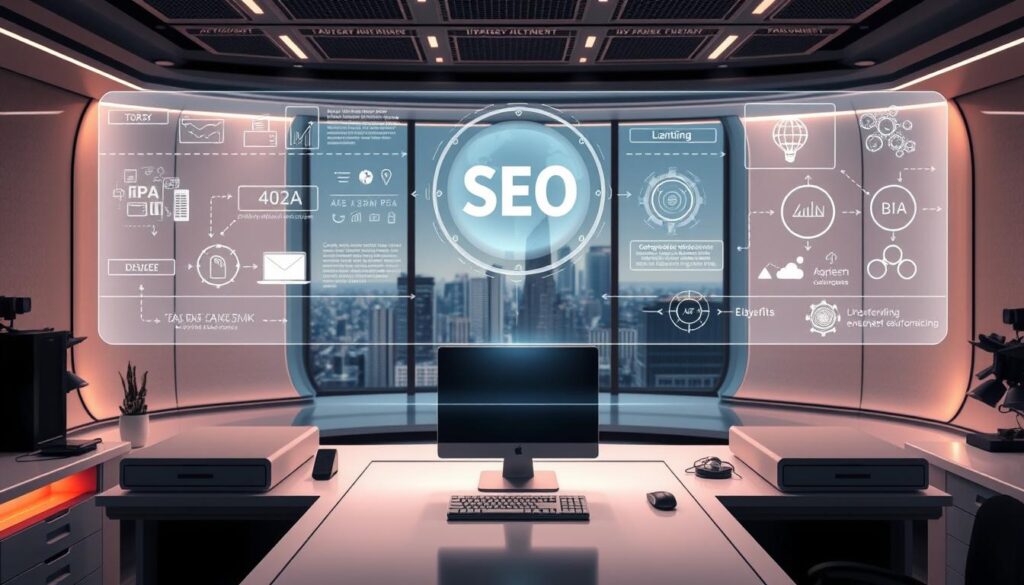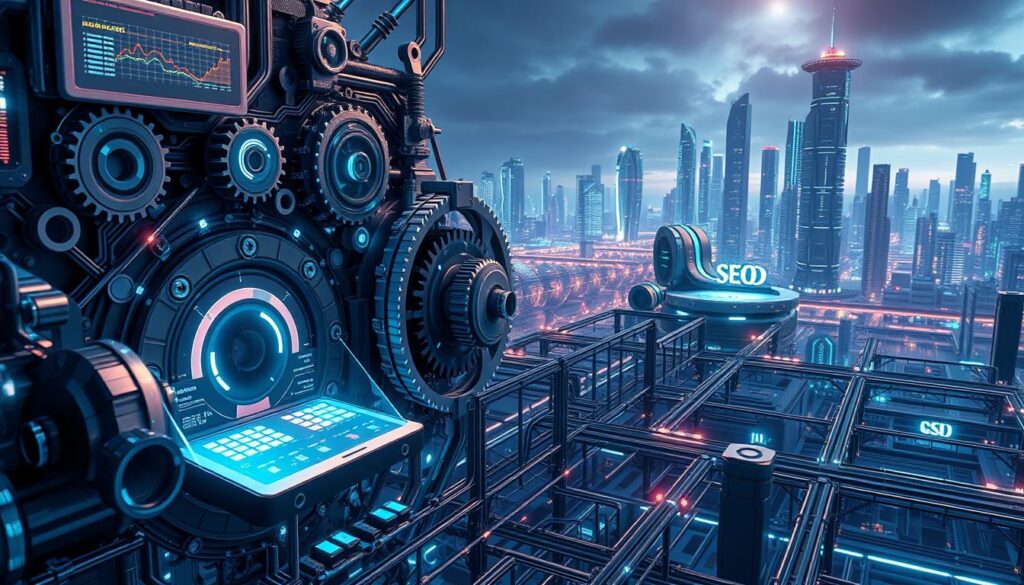The landscape of search engine optimization is evolving rapidly as autonomous systems redefine traditional workflows. Modern tools now integrate real-time data analysis, automated decision-making, and multi-platform coordination to execute complex strategies. This shift enables businesses to achieve results that once required specialized teams, all while maintaining compliance with ever-changing search algorithms.
Recent advancements include platforms capable of handling keyword research, content alignment, and performance tracking in unified processes. For example, emerging solutions like those in public beta phases demonstrate how AI agents can reduce manual intervention by 80% while improving outcome consistency. These systems analyze SERP patterns, competitor activities, and user intent signals simultaneously – a task impractical for human operators at scale.
Organizations adopting these technologies report improved search rankings within weeks rather than months. The capability to instantly adjust strategies based on live data helps maintain visibility amid fluctuating market conditions. This approach particularly benefits time-constrained professionals seeking efficient ways to manage their digital presence without deep technical expertise.
Key Takeaways
- Autonomous SEO systems reduce manual work by automating multi-step processes
- Real-time data integration enables faster strategy adjustments than traditional methods
- Advanced platforms handle keyword analysis and content alignment simultaneously
- Businesses achieve measurable ranking improvements within shorter timeframes
- Reduced dependency on specialized skills lowers operational costs
Introduction to SEObot Agentic Optimization

Digital marketing strategies are undergoing a fundamental transformation as intelligent platforms redefine how professionals approach search visibility. Unlike conventional tools limited to single functions, modern solutions combine strategic planning with rapid execution across interconnected workflows.
Definition and Origins
Autonomous SEO systems emerged from the need to streamline complex processes like keyword mapping and content synchronization. These AI agents function as digital strategists, analyzing search trends while coordinating technical adjustments across websites. Early prototypes focused on automating repetitive tasks, but current iterations handle multi-layered campaigns through self-directed decision-making.
The Role of AI in Modern SEO
Advanced systems now integrate live market data with historical performance metrics to predict algorithm changes. This capability allows businesses to adapt faster than traditional methods permitted. For instance, certain AI tools can audit site structures while simultaneously generating optimized content variations – a dual-action approach that maximizes efficiency.
The technology’s true value lies in its capacity to connect disparate data points. By evaluating competitor backlink profiles alongside user engagement patterns, these platforms identify improvement opportunities most teams would overlook. This holistic method ensures consistent visibility across evolving search ecosystems.
How AI is Transforming SEO Workflows

Modern search optimization now operates at machine speed. Where teams once spent weeks coordinating manual processes, intelligent systems complete equivalent tasks in minutes. This shift eliminates time-intensive bottlenecks while maintaining precision across multi-step campaigns.
Automation and Efficiency Gains
Traditional SEO workflows consumed 16-22 hours per project through sequential steps:
| Process | Time Investment | Tools Required |
|---|---|---|
| Goal alignment meetings | 1-2 hours | Communication platforms |
| Competitor analysis | 4-6 hours | Multiple rank trackers |
| Data aggregation | 6-8 hours | Analytics suites |
AI-driven systems collapse these stages into unified workflows. One marketing director noted: “Our team reclaimed 300+ hours quarterly by automating data pulls from 12+ sources.” Algorithms now handle keyword clustering, content gap analysis, and reporting without human intervention.
Real-Time Data Integration
Current platforms merge live search trends with historical performance metrics. This dual-timeframe analysis identifies emerging patterns before manual methods detect shifts. Systems cross-reference:
- Search engine API updates
- Competitor backlink velocity
- User engagement fluctuations
By processing these signals simultaneously, AI tools generate actionable insights within 15 minutes – a task requiring 8+ hours manually. This velocity enables brands to capitalize on time-sensitive ranking opportunities that previously expired before detection.
The Evolution of SEO: From Manual to Programmatic Techniques

Search optimization practices have undergone radical transformation as intelligent systems replace labor-intensive workflows. Where teams once dedicated weeks to manual audits, modern solutions deliver actionable insights in minutes through automated pattern recognition and live data synthesis.
Traditional Methods vs. AI-Driven Processes
Legacy SEO workflows required extensive coordination across multiple stages:
| Stage | Manual Approach | AI-Driven Process |
|---|---|---|
| Goal Analysis | 3+ stakeholder meetings | Automatic request classification |
| Competitor Research | Manual page reviews | Live SERP data extraction |
| Reporting | Spreadsheet compilation | Instant multi-format outputs |
Traditional methods consumed 10-15 hours per project. AI alternatives complete equivalent tasks in under two minutes while analyzing more data sources. This efficiency allows teams to focus on strategic decisions rather than administrative work.
Programmatic systems excel at detecting subtle correlations between algorithm updates and site performance. By continuously monitoring search trends, these tools adjust content strategies faster than manual methods permit. For example, certain AI-powered SEO tools now predict ranking fluctuations before official algorithm announcements.
The shift enables smaller businesses to compete with enterprise-level resources. Real-time adjustments to metadata, internal linking, and content gaps occur automatically – processes that previously required specialized teams. This accessibility revolutionizes how organizations approach search visibility across multiple sites.
Understanding SEObot agentic optimization

Modern SEO systems are designed to handle intricate processes through intelligent automation. These platforms combine strategic analysis with adaptive execution, addressing challenges that overwhelm manual methods. By merging user intent interpretation with technical adjustments, they create cohesive strategies across multiple channels.
Mechanisms Behind Agentic Optimization
Advanced AI analyzes search patterns using natural language processing. It identifies keyword relationships and content gaps by cross-referencing:
- Historical performance metrics
- Competitor backlink strategies
- Real-time algorithm updates
Machine learning refines strategies based on outcome data. For example, one platform reduced manual tasks by 75% while improving keyword targeting precision. These systems execute multi-step workflows autonomously, from content generation to technical audits.
Key Benefits for SEO Practitioners
Professionals gain significant advantages through automated solutions:
| Metric | Traditional Approach | AI-Driven Process |
|---|---|---|
| Time per project | 8-12 hours | 18 minutes |
| Keyword coverage | 150 terms/month | 1,200 terms/month |
| Content updates | Weekly batches | Real-time adjustments |
Businesses report 40% faster ranking improvements using these tools. Automated systems also minimize errors in metadata and internal linking. As one marketer noted: “We manage five sites simultaneously now – something impossible with manual methods.”
Continuous monitoring ensures strategies adapt to evolving search algorithms. This proactive approach helps maintain visibility despite frequent industry changes.
Best Practices for Implementing AI-Driven SEO Strategies

Adopting intelligent SEO solutions demands a structured approach combining technical precision with strategic oversight. Organizations must balance automation capabilities with human expertise to maximize visibility while maintaining brand integrity.
Strategic Planning and Setup
Effective implementation begins with defining clear objectives. Teams should establish measurable KPIs aligned with business goals, such as target keyword rankings or organic traffic growth. Configuration involves connecting AI tools to data sources like analytics platforms and CMS systems.
Proper integration ensures automated workflows complement existing processes. For example, AI agents can sync with content calendars to schedule optimizations during low-traffic periods. This setup phase often produces two critical documents:
- Research Analysis Reports with keyword difficulty scores
- Final Roadmaps outlining content adjustments
Execution and Workflow Management
AI-generated recommendations require human validation before deployment. Teams should create review checklists covering factors like brand voice consistency and technical feasibility. One marketing manager noted: “We approve 85% of suggestions after minor tweaks – the system handles the heavy lifting.”
Flexible execution frameworks allow quick pivots based on performance data. Real-time dashboards help monitor multiple campaigns simultaneously, ensuring alignment with evolving search trends.
Continuous Improvement and Analysis
Monthly audits assess AI accuracy by comparing predicted vs. actual ranking outcomes. Teams identify patterns where human intervention improves results – particularly for nuanced strategy adjustments in competitive niches.
Ongoing analysis should track:
- Content update frequency
- Algorithm update responses
- ROI per optimization task
This iterative process ensures systems evolve alongside search engine requirements while preserving strategic oversight.
Leveraging Real-Time Data for SEO Enhancements
Access to instant insights now separates leading SEO strategies from outdated approaches. Modern systems analyze live search patterns, competitor moves, and algorithm shifts simultaneously. This capability transforms how teams optimize website performance and target high-value keywords.
Tools and Techniques for Live Data Extraction
Advanced platforms connect directly to search engine APIs and analytics tools. They pull metrics like traffic trends and ranking positions in minutes, not hours. For example:
| Process | Traditional Method | AI-Driven Method |
|---|---|---|
| Data Collection | Manual entry across 6+ platforms | Automated API aggregation |
| Time Spent | 6-8 hours weekly | 12 minutes |
| Sources | Separate spreadsheets | Unified dashboard |
These tools flag discrepancies between website performance and industry benchmarks. One marketing team reported “48% faster content updates using live rank tracking.” Systems cross-check data from Google Analytics, Ahrefs, and proprietary databases to ensure accuracy.
For those exploring AI-powered SEO strategies, real-time analysis proves critical. It enables swift adjustments to keywords and meta tags as search algorithms evolve. Leading AI solutions now process 1,200+ data points hourly – a scale unmanageable manually.
Case Studies and Real-World Use Cases in AI-Driven SEO
Practical implementations of intelligent systems reveal how businesses achieve measurable SEO improvements through automation. Teams using AI agents report completing projects in half the time while maintaining strategic depth. One marketing agency reduced content production bottlenecks by 68% through automated outline generation and real-time keyword validation.
SEO AI Agent Workflow Examples
A tech startup streamlined its process using an agent-based system. The platform autonomously:
- Analyzed 12,000 competitor backlinks in 23 minutes
- Identified 47 high-value keyword clusters weekly
- Generated meta descriptions with 92% approval rate
“We publish 18 articles weekly now versus six before,” noted their content director. This efficiency stems from unified workflows replacing manual data transfers between tools.
Impact on Traffic and Rankings
Early adopters saw organic traffic spikes within 45 days. A comparison of manual vs. AI-driven strategies shows:
| Metric | Traditional Approach | AI Implementation |
|---|---|---|
| Monthly Keyword Gains | 32 | 127 |
| Content Update Frequency | Biweekly | Daily |
| Ranking Fluctuation Response | 14-day delay | 48-hour adjustment |
These results demonstrate how real-time data integration prevents outdated strategies. Systems flag ranking drops within hours, enabling rapid course corrections that preserve website visibility.
Key Features and Functionalities of SEObotAI
Advanced SEO solutions now combine scalable automation with adaptive workflows. These platforms address diverse optimization needs through unified systems that handle technical adjustments, content alignment, and global market demands.
Programmatic SEO and Automated Content
Programmatic features execute large-scale tasks like keyword targeting and metadata updates. Automated workflows generate blog posts and optimize existing content using natural language processing. This approach maintains readability while aligning with search algorithms.
Key capabilities include:
- Bulk technical SEO implementations across multiple sites
- Dynamic content structure adjustments based on SERP patterns
- Real-time optimization of meta tags and headers
Multi-Language Support and CMS Integration
Global enterprises benefit from tools that adapt strategies across languages. Platforms analyze cultural nuances and local search trends, enabling consistent SEO execution. Direct CMS connections allow instant content updates through AI tools without manual data transfers.
Integrated systems sync with WordPress, Shopify, and custom platforms. This eliminates workflow bottlenecks while preserving brand voice across regions. Users manage multilingual sites through single dashboards, reducing operational complexity.







